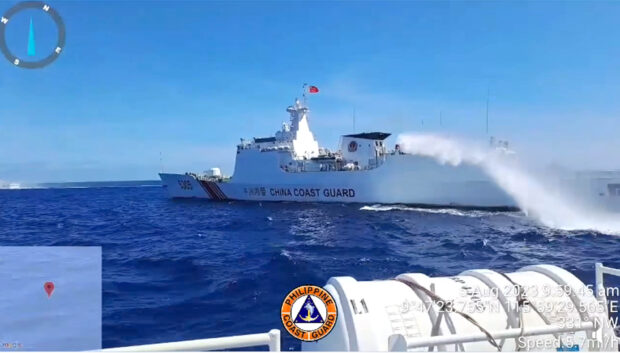Joint patrols as escort for Ayungin trips pushed

To ensure the success of the next resupply mission to BRP Sierra Madre, the country’s military outpost at Ayungin (Second Thomas) Shoal, legal and security experts have suggested that it be carried out during joint patrols with foreign allies.
According to former Senior Associate Justice Antonio Carpio, the government should follow the lead of Malaysia and Indonesia which, despite warnings from the China Coast Guard, successfully conducted survey and naval drills with the United States and Australia in their respective exclusive economic zones (EEZs) in the South China Sea.
“We can have joint patrols with the US at the same time [as the next resupply mission to the Ayungin Shoal]. We can calibrate it,” Carpio, a staunch advocate of Philippine sovereignty in the West Philippine Sea (WPS), said on Thursday in a forum organized by Stratbase ADR Institute in partnership with the US Institute of Peace.
“The Americans are there. They did the Malaysians and Indonesians a favor even without a defense treaty. And the Australians also did the same to Malaysia. Why are they doing this? Because they want to preserve freedom of navigation … We can do all these things. It’s up to us if we have the political will,” he added.
Carpio pointed out that if Indonesia and Malaysia were able to conduct joint drills without a Mutual Defense Treaty with the United States, then the Philippines, which has one, can use the same strategy in its next resupply mission to BRP Sierra Madre.
‘Not to cause war’
For Stratbase president Dindo Manhit, the Philippines should not be deterred from sending supplies and improving BRP Sierra Madre.
“Our supply ships should really push through …. This is where we can maximize joint patrols and be shepherded by allies and friends during the resupply [mission]. Not to cause war but simply to exercise our own rights based on international law. Our military outpost is within our EEZ,” he noted.
Leverage against China
Security expert and former United States Air Force official Col. Raymond Powell agreed, saying that one of the leverages the Philippines could use when dealing with an “extremely large and aggressive country like China” was its partnership with like-minded allies.
Powell, who is also a fellow at the Gordian Knot Center for National Security Innovation at Stanford University, said that Ayungin Shoal, including BRP Sierra Madre, was the “most vulnerable outpost” in the entire South China Sea and should be reinforced.
“It’s vulnerable not just because of how few people are there and their inability to defend themselves but the fact that their outpost is deteriorating and will ultimately succumb to time and the weather and the elements,” he explained. “That will happen unless the Philippines and its US allies are able to come up with some other solution to repairing or replacing, somehow lifting, circumventing, and defeating the ongoing Chinese blockade.”
400 foreign vessels
Noting the presence of over 400 foreign vessels, mostly Chinese, in the country’s EEZ in WPS, Armed Forces of the Philippines chief of staff Gen. Romeo Brawner Jr. stressed the need to pursue the military’s modernization program so it could deploy more assets to the area. “We need more ships, aircraft, air defense systems, and drones. We need many vessels and equipment. I hope that the public and private sectors help the AFP in this aspect,” said Brawner who visited the AFP Western Command (Wescom) headquarters in Puerto Princesa, Palawan on Thursday, just days after the Chinese coast guard fired water cannons at Philippine boats on a resupply mission to BRP Sierra Madre.
At a press briefing, AFP Wescom chief Vice Adm. Alberto Carlos said that of the around 400 foreign ships in the WPS, 340, or 85 percent, were Chinese vessels, adding that in the waters at Panganiban (Mischief) Reef alone—250 kilometers west of the Palawan mainland—there were already 191 foreign ships.
Brawner said additional funds were also needed to improve the military’s other facilities in WPS to “strengthen our presence.”
As for the AFP’s plan to deploy its own maritime militia to boost the country’s presence in its EEZ, Brawner said this would depend on available funds for the platforms or vessels, noting that reserve units have already been established for deployment to the area.
“When we say reserve force, it’s not just land-based forces so we are also trying to develop our reservists who will be able to operate in the sea,” he told reporters at the sidelines of his visit. “It’s already being implemented. We have established reserve units but we are going to wait for the platforms or the vessels that will be used.”
“But definitely, we are pursuing that direction very soon,” Brawner said, adding that the AFP was also looking at tapping fisherfolk as reservists to defend the country’s waters.
“We really have to establish our presence in the area. It’s a game of numbers. Naturally, we can’t match China because we have fewer vessels. Definitely, we will try to deploy more ships and fishing vessels,” he said.
RELATED STORIES
Navy crew in resupply mission in BRP Sierra Madre says ‘they were unarmed’
AFP chief: Gov’t plans to deploy naval reservists to counter Chinese maritime militia in WPS
Too early to invoke US-PH Mutual Defense Treaty after China’s water cannon attack — DFA
PCG: We use water cannons to put out fire, not to chase away Chinese vessels